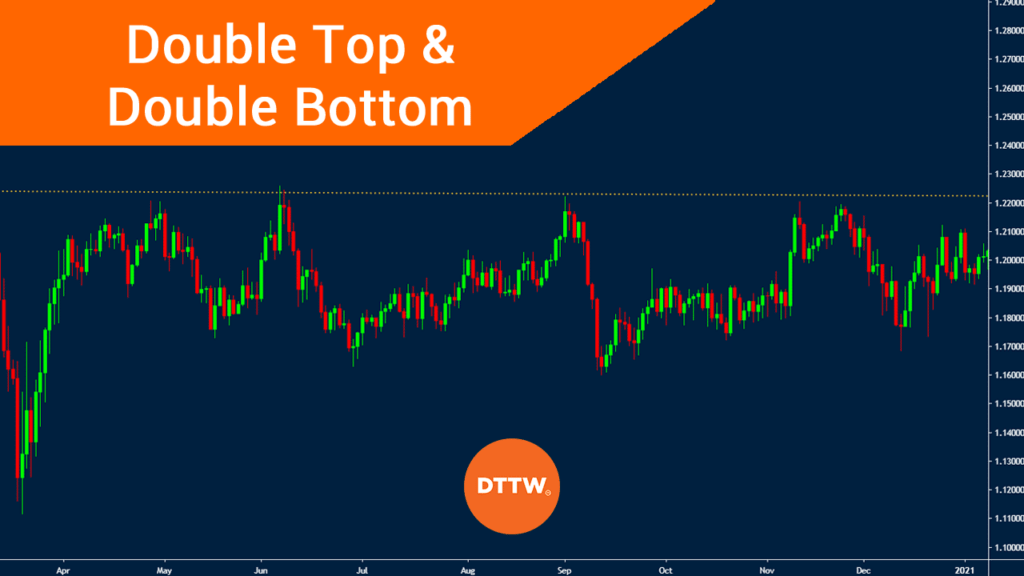Chart patterns are important features used in the price action trading strategy. They refer to the process of looking at charts on all timeframes and then identifying the various patterns. You can then use these patterns to predict the future movement of a financial asset.
In the past, we have looked at other chart patterns in the market, including triangles, bullish and bearish pennants and flags, and cup and handle patterns.
In this article, we’ll focus on two vital reversal patterns known as double top and double bottoms.
Table of Contents
What are reversal patterns?
The most profitable trader is the one who identifies a reversal early enough and then rides the new trend. In most cases, however, it is extremely difficult to identify brand new trends in the market.
Therefore, day traders and investors use several strategies to predict the formation of a reversal. Some use technical indicators like moving averages and Relative Strength Index (RSI).
Other traders use chart patterns like head and shoulders (H&S), rising and falling wedges, and triple tops to predict these reversals. Like other trading techniques, these patterns are not always accurate but they can help you identify these reversal moves.
Role of volume in trading double top and double bottom
Volume is an important part of trading chart patterns, technical indicators, and even candlestick patterns. In most periods, strong moves are usually confirmed by higher volume. For example, if a stock makes a huge move with no high volume, it can be said to be a pump and dump.
Therefore, when trading a double-top or a double-bottom pattern, you will often see low volume during its formation and a higher one during the breakout or breakdown period.
In most cases, however, many traders don’t focus on volume so much when trading the double-top and double-bottom patterns.
Double top
A double top is a bearish reversal pattern that forms in all financial assets, including stocks, commodities, forex, and exchange-traded funds. The pattern is formed when the price of a financial asset forms two peaks at the same level.
In other words, the price faces substantial resistance as bulls struggle to move above it. When this happens, the overall prediction is that the price will then have a pullback in the near term.
How to identify a double top pattern
Identifying a double-top pattern is a relatively easy process. First, you need to identify a financial asset whose price is rising. Then, you should spot when it made the first pullback and the second pullback.
In most times, the level of the pullback will be the same and is known as the neckline. If you spot such a pattern, the likelihood is that the price will drop when it hits the second peak.
A good example of this is shown in the GBP/CHF chart below.
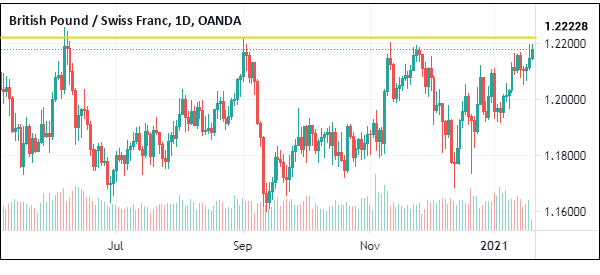
As you can see, the pair started moving upwards when it bottomed at the 1.1113 level. It then soared and reached the first peak at the 1.2200 level and then started dropping. Then, it arrived at the same level a few months later, sending a bearish signal. The price then dropped and moved slightly below the neckline,
As you can see, this pattern continued for a few months whereby it dropped after hitting the resistance level.
So, why is the peak of the double top pattern important?
In the chart below, we see that the price is on the same level as the 50% Fibonacci retracement. Also, the neckline of this pattern is at the same level as the 38.6% Fibonacci retracement level.
Therefore, when using this approach, it is vital for you to work with tools like the Fibonacci and Andrew’s pitchfork.
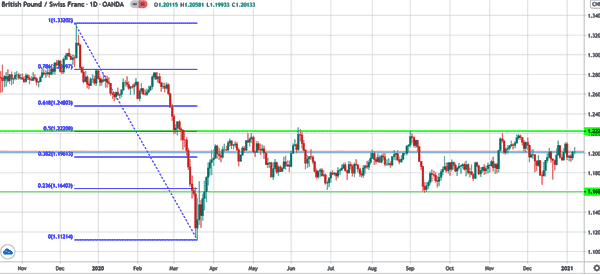
Double bottom
The double bottom is the exact opposite of the double top pattern. It forms when the price of an asset finds strong support at a certain level.
At this stage, some bears start to exit, which pushes the price higher. It then rises to the neckline, where it finds resistance. Finally, it drops and reaches the initial level of resistance and then bounces back. The pattern ends where the price breaks out higher.
Example of Double Bottom
A good example of this is in the AMC shares shown below. For starters, AMC is an embattled company that runs the biggest theater chain in the United States. Due to Covid, the company has seen its revenue fall as people stay at home. Film companies have also been putting-off new movie launches.
As a result, the shares dropped to a multi-year low of $1.95 in 2020 and then recovered to $7.33. As you can see, it formed a double top near this level and then dropped. It then formed a double-bottom at $3.35, where it then bounced back.
At the beginning of 2021, we saw that the share price was also forming a double bottom pattern. As a result, we could easily predict that the price is bound to bounce back.
Like in the double top example above, we also see that the price found a strong resistance at the 38.2% Fibonacci retracement level.
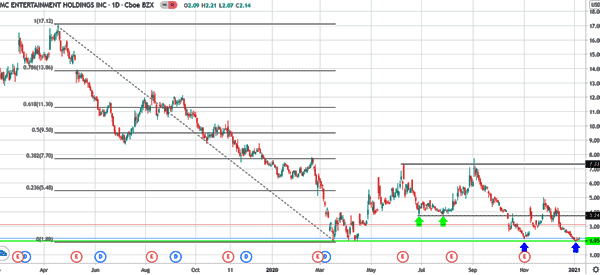
Entry and exit strategies
The double-top and double-bottom patterns are relatively easy to use, as mentioned above. In this case, the two most important levels are the double-top or bottom and the neckline.
In the case of a double-top, there are two key scenarios. First, there is a possibility of the asset failing to have a reversal. Therefore, in this case, one can place a buy-stop above the double-top pattern. In this case, the buy-stop order will be executed.
A good example of this is shown below. The stock formed a double-top at $10.21 whose neckline was at $8.29. Here, the stock’s double-top did not lead to a reversal. As such, a trader would place a buy-stop and ride the bullish trend.

The other approach is to place a sell-stop below the neckline of the chart. The hope is that the trade will be executed when the price makes a bearish breakout.
Another way to find an entry is to wait for a break and retest the approach. This is a situation where the price has a bearish breakout and then retests the neckline. A good example of this is shown below.
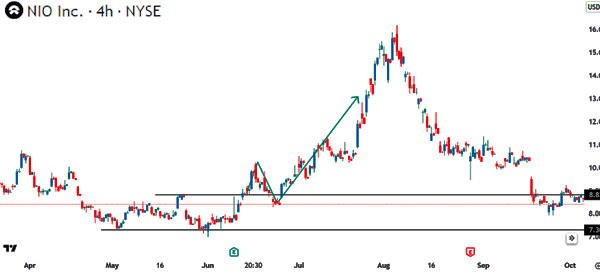
In this chart, we see that the stock formed a double-bottom at $7.30 and a neckline at $8.83. It then broke out and retested the neckline at $8.83 and then resumed the rally.
The other part in all this is how to place a take-profit and a stop-loss. One of the most popular approaches is to place a stop-loss at the double-top level. In the example above, you would add a stop-loss at $7.30.
The profit target is established by measuring the distance between the double-top and the neckline. After doing that, you measure the distance from the neckline.
How to combine double bottom and top with indicators
Another way of using the double-top and double-top patterns is to combine it with several indicators. The moving average is one of the most popular indicators to use in this. One of the top approaches is to use a golden or a death cross.
A death cross happens when the 200-day and 50-day moving averages make a crossover. Most traders use shorter timeframes to find crossovers. Therefore, if a double-bottom forms, a trader can enter a buy trade when the golden crossover happens.
Psychology of double-top and double-bottoms
A common feature of most chart patterns is that they both have a psychological aspect. It is these psychological factors that cause their price movements over time.
For example, a double-top pattern is formed when a financial asset fails to move above an important psychological level known as a resistance point. A double-bottom, on the other hand, is formed when the price fails to move below a key support level.
Let us look at the example below. In this case, we see that the Tilray share price formed a double-top pattern at $3.08 and the neckline at $2.23. This is an important level because $3 is an essential psychological level. Therefore, a bearish reversal was confirmed when it moved below the neckline at $2.23.

The psychological aspect also happens because traders and investors are aware of the implications of the pattern.
Advantages of using double bottom and double top
There are several benefits of using the double bottom and double top patterns in the financial market.
First, as you have seen above, they are relatively easy to identify. You just need to do a visual assessment and use the trendline tools that are offered by your trading platform to draw them.
Second, it is easy to incorporate other trading tools when using the double top and double bottom. As you have seen above, we have easily incorporated the concept of Fibonacci retracement. Also, it is relatively easy to use technical indicators like the Relative Strength Index (RSI), momentum, and the Relative Vigor Index (RVI).
Third, while the double top and bottoms are not always accurate, they often lead to positive results. This is because the concept is ingrained in the minds of other financial traders.
Cons of double bottom and double top
However, there are several disadvantages or cons of using the double top and bottom pattern.
First, like all chart patterns, they are not always accurate. At times, instead of a reversal, the price could continue moving in the original direction. A good example is in the USD/ZAR pair shown below.
As you can see, the price formed a triple-bottom pattern and ultimately broke-out lower.
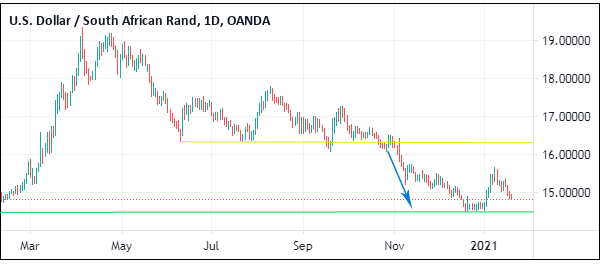
Second, the double top and bottom patterns are relatively rare in the market. At times, it will take you a substantial amount of time before you spot these patterns.
Third, and finally, the patterns are not always useful for scalpers and ordinary day traders. That’s because the two patterns can take a few months to form fully.
Common mistakes when using double-tops and bottoms
There are several common mistakes that most people make when using the double-top and double-bottom pattern. Some of the most notable mistakes are:
- Not having a stop-loss or a take-profit – This is wrong. Like all chart patterns, these double tops and bottoms are not always accurate. As such, it is always important to protect them.
- Open a trade too early – Many traders make the mistake of opening their trades very early. In most cases, it is recommended to wait for the break and retest.
- Fail to look at volume – Further, many traders ignore using volume when using the chart pattern.
- Fail to do multi-time analysis – The other mistake is to make an analysis based on one chart timeframe.
Final thoughts
Double top and double bottoms are important concepts in the financial market. They are vital patterns that you can use to identify reversals across all asset classes. They are also relatively easy to identify.
Therefore, we recommend that you take time to study, test, and use them in your day trading.
External Useful Resources
- How to Identify High Probability Double Top & Double Bottom Patterns – ForexWithAnEdge



